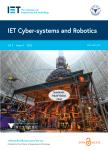Self‐supervised monocular depth estimation via asymmetric convolution block
作者机构:Department of Control Science and EngineeringTongji UniversityShanghaiChina
出 版 物:《IET Cyber-Systems and Robotics》 (智能系统与机器人(英文))
年 卷 期:2022年第4卷第2期
页 面:131-138页
核心收录:
学科分类:07[理学] 0701[理学-数学] 0811[工学-控制科学与工程] 0812[工学-计算机科学与技术(可授工学、理学学位)]
基 金:Natural Science Foundation of Shanghai,Grant/Award Number:61922063 National Key R&D Program of China,Grant/Award Number:2018YFB1305003 Fundamental Research Funds for the Central Universities Shanghai Hong Kong Macao Taiwan Science and Technology Cooperation Project,Grant/Award Number:21550760900 Shanghai Municipal Science and Technology Major Project,Grant/Award Number:2021SHZDZX0100。
主 题:asymmetric convolution block(ACB) KITTI dataset self‐supervised depth estimation
摘 要:Without the dependence of depth ground truth,self‐supervised learning is a promising alternative to train monocular depth estimation.It builds its own supervision signal with the help of other tools,such as view synthesis and pose networks.However,more training parameters and time consumption may be involved.This paper proposes a monocular depth prediction framework that can jointly learn the depth value and pose transformation between images in an end‐to‐end manner.The depth network creatively employs an asymmetric convolution block instead of every square kernel layer to strengthen the learning ability of extracting image features when training.During infer-ence time,the asymmetric kernels are fused and converted to the original network to predict more accurate image depth,thus bringing no extra computations anymore.The network is trained and tested on the KITTI monocular dataset.The evaluated results demonstrate that the depth model outperforms some State of the Arts(SOTA)ap-proaches and can reduce the inference time of depth prediction.Additionally,the pro-posed model performs great adaptability on the Make3D dataset.



